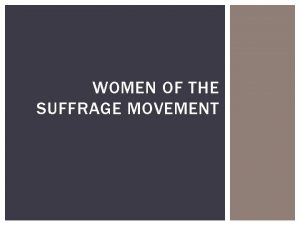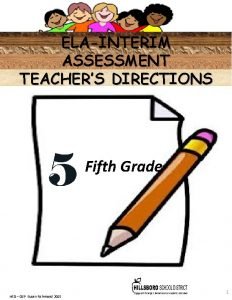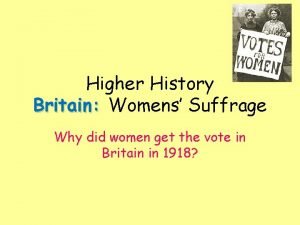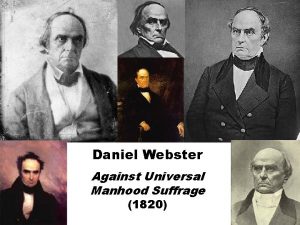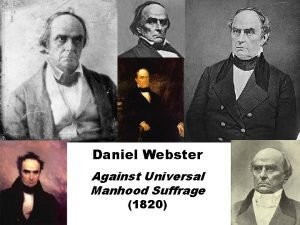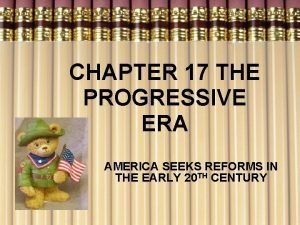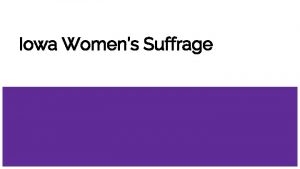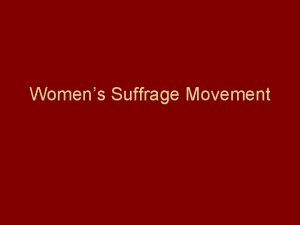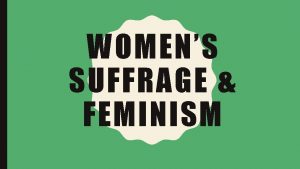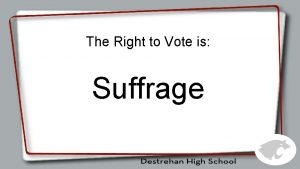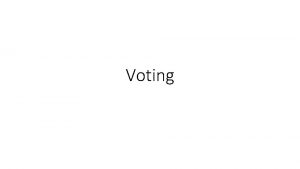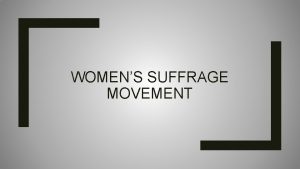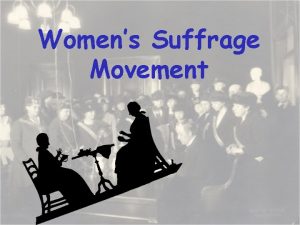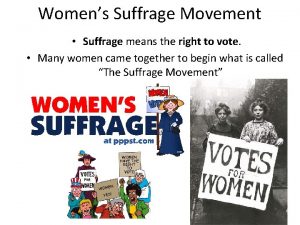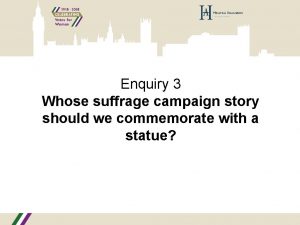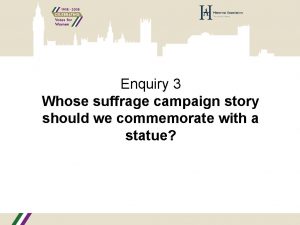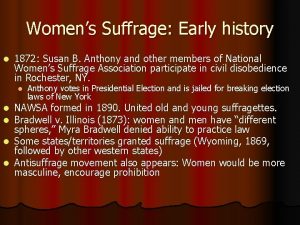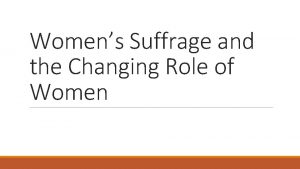The Suffrage Campaign The early campaign Role of



























- Slides: 27

The Suffrage Campaign • • The early campaign Role of socialism and the Labour Party Suffrage reinvigorated Anti Suffragism Men in the suffrage movement Women’s organisations and methods Gaining the vote Conclusion

Gendered histories • • • Nineteenth century politics seen as almost wholly male… …but women are everywhere Rhetoric of separate spheres (Davidoff & Hall, Family Fortunes) confines women to the home – but the home is often political New women’s history (Kathryn Gleadle, Claire Midgley, Elaine Chalus, Sarah Richardson) look at female agency Has led to a new understanding of masculinity (John Tosh)

The Early Campaign • In 1867 J. S. Mill hands a petition signed by 1, 500 women to the House of Commons to have a women’s suffrage amendment added to the 1867 Reform Act. The petition fails. Many more working class men enfranchised by the Act and again by a further Reform Act in 1884. • Organised suffrage campaign starts in 1867 in response, with the founding of two major women’s suffrage committees, one in London the other in Manchester: The London Society for Women’s Suffrage and the Manchester Society for Women’s Suffrage. Depiction of J. S Mill being presented with the suffrage petition in 1867

• The London Society had J. S Mill as its president and included Millicent Garrett Fawcett who later became leader of the law abiding National Union of Women’s Suffrage Societies (NUWSS). It was a conservative group Most members were middle class Liberals. • The Manchester Society sought to develop a large scale, nationwide campaign inspired by the anti corn law movement. Lydia Becker did much to inspire this by travelling and speaking up and down the country. Emmeline Pankhurst who was later to become the charismatic leader of the ‘militant’ Women’s Social and Political Union (WSPU) was part of the Manchester movement. The Society had links with the working class and industrial politics of the north.

Tensions • Disagreement on how to run the campaign and on what women’s suffrage demands should be. Had to rely on convincing male members of parliament to take up their cause if they were to succeed. • Differences over whether married women should be included in suffrage demands or not. • Disagreements over extending the vote to all women. • This slowed the progression of the campaign and it continued to rely on low key lobbying rather than mass campaigning.

Women’s Suffrage and Socialism. • Women’s suffrage had been a feature of early socialist debate among Owenite and Chartist movements. • Socialist ideology became more influential. Several socialist organisations formed including the Independent Labour Party (1893). • ILP advocated universal suffrage (the vote for men and women). This meant a lack of support within the Party for a separate women’s suffrage bill. • ILP ambivalence also because suffragists demand for the vote, ‘on same terms as men’ would have mostly enfranchised propertied middle and upper class women who traditionally voted Conservative.

• Some influential voices within the ILP, such as Keir Hardie, pushed the Party to adopt a separate women’s bill • Many suffragists including the Pankhursts were early ILP members. Sylvia Pankhurst became a committed socialist and suffragist which caused a split between her and her mother and sister, Emmeline and Christabel, who moved the WSPU away from its working class and socialist origins. • Many socialist women were torn throughout the campaign between class and gender

Women’s Suffrage and the Labour Party • In 1900, the ILP and other socialist and trade union organisations joined together to form a group to work for universal suffrage inside the House of Commons hence the Labour Party was formed. • Conciliation Bill debacle of 1910 -12. Bill proposed a women’s suffrage amendment to the existing franchise which the Liberal government pledged to consider. After several readings, the bill failed and the government proposed further extension to male suffrage instead. • 1912 - Labour Party announced it ‘could find no [government] bill acceptable that does not include women’. • NUWSS now believed the Labour Party offered the best prospect for women’s suffrage and formed an influential alliance. Sylvia Pankhurst split from the WSPU to form the East London Federation of Suffragettes (ELF) which was aligned to the Labour Party.

The Suffrage Movement reinvigorated • Suffrage movement reinvigorated in the with formation of the WSPU. • More women joined the campaign benefitting all suffrage organisations • Movement attracted a more diverse range of support. • Liddington and Norris among first to show greater level of working class involvement than previously thought: Annie Kenney and Hannah Mitchell high profile examples. • Movement relied heavily on propaganda techniques to convey its message



Anti suffrage campaign • Reinvigoration of suffrage campaign led to similar invigoration of anti suffrage movement. • Anti arguments drew on notions of separate spheres • The most famous female anti suffragist was the novelist Mrs. Mary Humphrey Ward (1851 -1920). She wrote on the topic, publishing an essay, ‘An appeal against women’s suffrage’ in 1889. • Supported the ‘forward policy’ which was essentially to encourage women’s further involvement in local politics • Female anti suffragism became official with the founding of the Women’s National Anti-Suffrage League in 1908 later joined with the men’s league to become the, National League for opposing Women’s Suffrage. • By 1910 they had over 100 branches, 16, 000 members and 400, 000 signatures on petitions.

Unsurprisingly, many men were anti suffragists and their arguments for women’s exclusion from the franchise drew on: women’s lack of common sense; Their tendency to be ruled by emotion or their physiological shortcomings due to menstruation or child bearing; or, as in these examples of anti suffrage propaganda, the neglect of the home and children or women’s questionable mental capacity compared to men.

Men in the Suffrage Movement • Men had always been involved in the women’s suffrage campaign and many had socialist, Labour Party or ‘left wing’ affiliations. • Frederick Pethwick Lawrence - Cambridge graduate, trained in law, started as Liberal candidate. After meeting his wife, Emmeline, he moved away from the Liberal Party becoming immersed in the WSPU and left wing politics. • William Ball was an anomaly as a working class man and trade unionist. Arrested for window smashing in 1911 he was imprisoned with hard labour and was force fed repeatedly when he went on hunger strike. Eventually suffered temporary mental breakdown.

• Men’s organised suffrage groups began to form in the mid 1900’s as auxiliaries to women’s suffrage groups. • The Men’s League for Women’s Suffrage (MLSW)(1907) was formed by a group of largely middle class, left wing radicals. This was followed by the Men’s Political Union – a male wing of the WSPU that carried out militant tactics and acted as WSPU bodyguards. • By 1910, the MLSW had 10 branches around the country. • Men’s position in the movement was difficult. Most work was carried out ‘behind the scenes’ to avoid usurping or interfering with the women’s actions.

Women’s Social and Political Union • Formed in 1903 in Manchester by Emmeline Pankhurst. • WSPU roots in ILP and working class politics. Originally called the Women’s Labour Representation Committee. • WSPU intended to combine suffrage work with the social goals of Labour and Socialist women activists. • "Deeds, not Words" was to be our permanent motto. ” E. Pankhurst, 1903.

• Moved headquarters from Manchester to London. Shot to prominence when Christabel Pankhurst and Annie Kenney initiated the militant phase of the suffrage movement. • ‘Unladylike’ tactics and arrest resulted in widespread national and international coverage and put the question of women’s suffrage on the public as well as political agenda. • Suffragette actions graduated from heckling to more violent methods including sabotage, vandalism, looting, arson, attacking MP’s and ultimately death.


• The cause was given its first martyr in 1913 when Emily Wilding Davidson ‘threw’ herself under the King's horse on Derby Day, 1913. • A martyr and hero to some, Emily represented to others why women shouldn’t get the vote. If this was what educated women could do what would less educated women be capable of if they did get the franchise?

• Violence was seen as state sanctioned and often described in gender specific terms. • Women were physically abused by men when giving public speeches on behalf of women’s suffrage. • Women complained that they were sexually molested by police officers when they were being arrested. • In prison women were force fed under the Liberal Government’s ‘Prisoners Temporary Discharge for Ill Health Act’ (1913) better known as the ‘Cat and Mouse’ Act. Likened by many suffragette victims to rape.


• The WSPU’s continued support of ‘wilder’ acts by its members, dismayed many. Pankhurst’s dictatorial leadership style also problem • 1907 – Teresa Billington-Greig and Charlotte Despard breakaway from the WSPU to form the Women’s Freedom League (WFL). • WFL had links to the socialist world and Labour politics as did another WSPU dissident group the United Suffragists in 1914. • A more radical fringe turned to anarchism, syndicalism and the politics of sexual liberation. The Freewoman, founded by two former WSPU organisers, Dora Marsden and Mary Gawthorpe, was their principal forum.

National Union of Women’s Suffrage Societies • Formed in 1897 and led by Millicent Garrett Fawcett. • Largest women’s suffrage organisation. Between 1907 and 1910 the number of societies affiliated with the NUWSS increased by more than 400, while its total membership increased by more than 50, 000 and its income quadrupled. • Continued tradition of earlier suffrage campaigning by persistently lobbying and petitioning the government. Publicised its activities through its official paper the Common Cause. • Effect of its tactics and work with the Labour Party are now recognised as having been undervalued in early suffrage histories that focused on the more dramatic WSPU.

Militancy • The difference between women ‘militants’ and ‘non militants’ attached to organisations like the WSPU and the NUWSS respectively, have often been exaggerated in histories of the campaign and must be treated cautiously. • Women often belonged to several suffrage organisations at the same time or shifted their allegiances as the campaign progressed. Regional branches often defied dictates from the leadership. • Militant has often been defined as ‘violent’. In this case, not many suffrage supporters were ‘militant’ as violent acts were carried out by very few women. Historical approaches to women’s activities in the campaign are now more nuanced.

World War I • By 1914 over 1, 000 suffragettes had been imprisoned. All the leading members of the WSPU were in prison, in very poor health or were living in exile. • Many organisations stopped campaigning for women’s suffrage. • At a meeting, attended by 30, 000 people, Emmeline Pankhurst called on Trade Unions to allow women to work in traditionally male sectors. • She denounced anti War socialist and Labour activists as ‘Bolsheviks’ including suffragists like Margaret Bondfield and Mary Mac. Arthur. Women’s International League for Peace & Freedom, The Hague 1915

Gaining the Vote • Limited women’s suffrage was eventually obtained with the 1917 Representation of the People Act. In the event, only women over the age of thirty were given the vote, which enfranchised some 7 million British women but left another 5 million still without the suffrage. • It is therefore hard to argue that women’s War work resulted in the suffrage as most young, female munitions workers were excluded. • Historians now argue threat of campaigning influenced the all-party committee to include women in the franchise legislation.

Conclusion • • • Early suffrage movements laid foundations for later mass campaigns Socialism had a significant impact on women’s suffrage campaigning. Many arguments for and against women’s suffrage relied on established notions of gender roles and differences although some were challenged by suffrage activists. How influential the campaign was in women achieving the vote, is still the subject of debate as are the pros, cons and definitions of militancy. The suffrage campaign was long, complex and fluid.
 Women suffrage
Women suffrage Suffrage
Suffrage The fight for women's suffrage readworks answer key
The fight for women's suffrage readworks answer key Higher history women's suffrage essay
Higher history women's suffrage essay Higher history women's suffrage essay
Higher history women's suffrage essay Universal male suffrage definition
Universal male suffrage definition Universal manhood suffrage
Universal manhood suffrage Women suffrage
Women suffrage Early cpr and early defibrillation can: *
Early cpr and early defibrillation can: * Soziale identität krappmann
Soziale identität krappmann Statuses and their related roles determine
Statuses and their related roles determine Worker role azure
Worker role azure Các châu lục và đại dương trên thế giới
Các châu lục và đại dương trên thế giới Từ ngữ thể hiện lòng nhân hậu
Từ ngữ thể hiện lòng nhân hậu Diễn thế sinh thái là
Diễn thế sinh thái là Tư thế ngồi viết
Tư thế ngồi viết Lp html
Lp html Thế nào là giọng cùng tên? *
Thế nào là giọng cùng tên? * 101012 bằng
101012 bằng Hát lên người ơi
Hát lên người ơi Khi nào hổ mẹ dạy hổ con săn mồi
Khi nào hổ mẹ dạy hổ con săn mồi đại từ thay thế
đại từ thay thế Vẽ hình chiếu vuông góc của vật thể sau
Vẽ hình chiếu vuông góc của vật thể sau Quá trình desamine hóa có thể tạo ra
Quá trình desamine hóa có thể tạo ra Công thức tính thế năng
Công thức tính thế năng Tỉ lệ cơ thể trẻ em
Tỉ lệ cơ thể trẻ em Thế nào là mạng điện lắp đặt kiểu nổi
Thế nào là mạng điện lắp đặt kiểu nổi Lời thề hippocrates
Lời thề hippocrates
